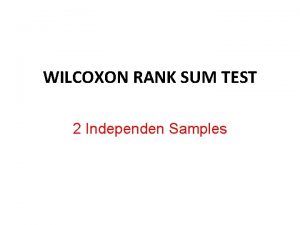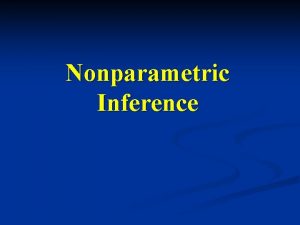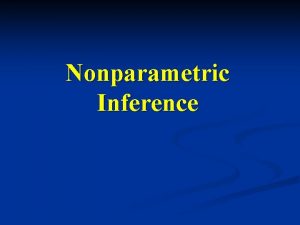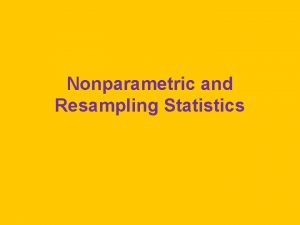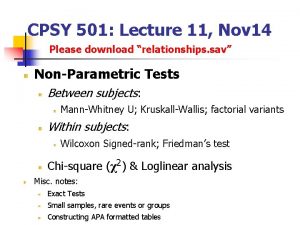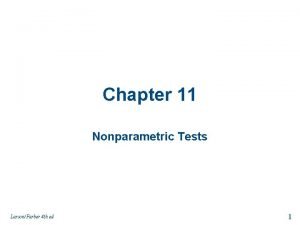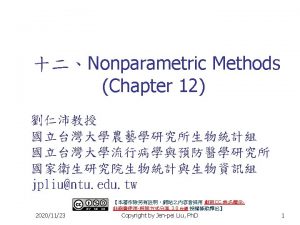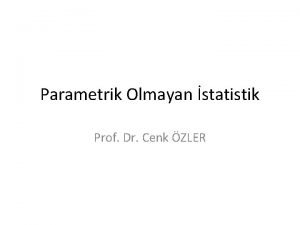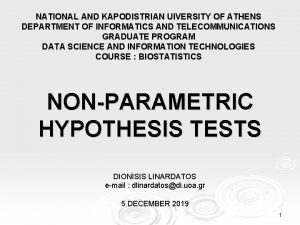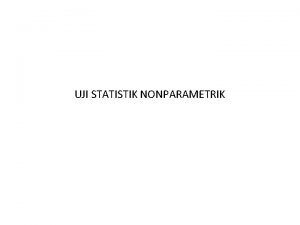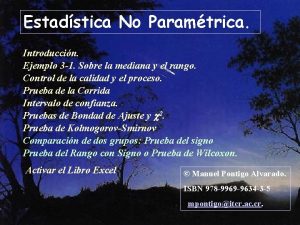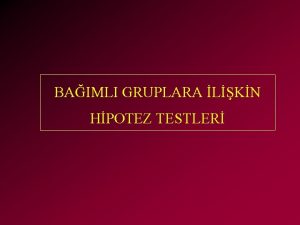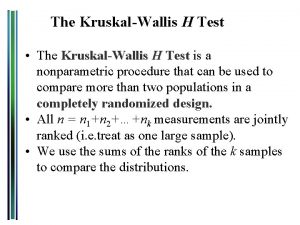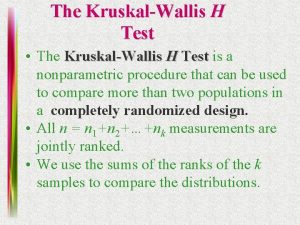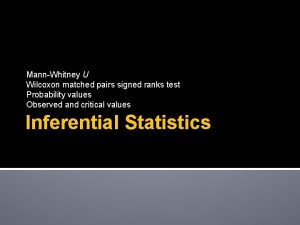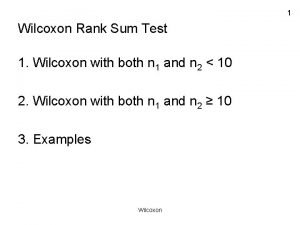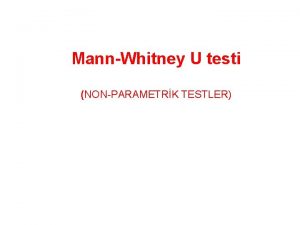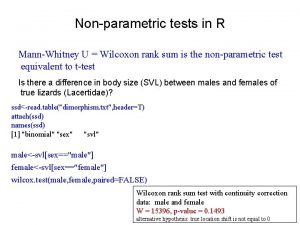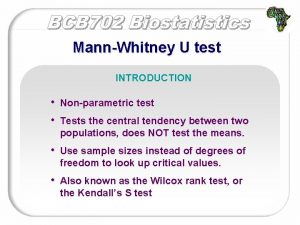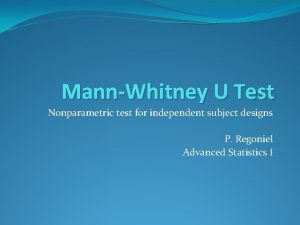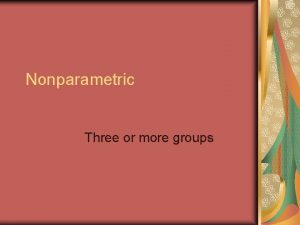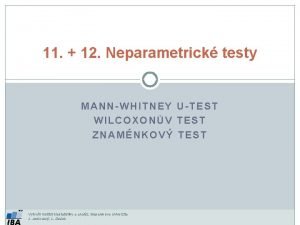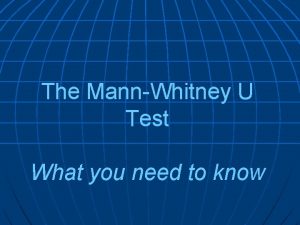KolmogorSmirnov test MannWhitney U test Wilcoxon test KruskalWallis
















- Slides: 16


§ Kolmogor-Smirnov test § Mann-Whitney U test § Wilcoxon test § Kruskal-Wallis § Friedman test § Cochran Q test

§ The Kolmogorov-Smirnov test (KS-test) tries to determine if two datasets differ significantly. § The KS-test has the advantage of making no assumption about the distribution of data. (Technically speaking it is non-parametric and distribution free. ) § In a typical experiment, data collected in one situation (let's call this the control group) is compared to data collected in a different situation (let's call this the treatment group) with the aim of seeing if the first situation produces different results from the second situation. § If the outcomes for the treatment situation are "the same" as outcomes in the control situation, we assume that treatment in fact causes no effect. Rarely are the outcomes of the two groups identical, so the question arises: How different must the outcomes be? Statistics aim to assign numbers to the test results; P-values report if the numbers differ significantly.

§ Kolmogor-Smirnov test § Mann-Whitney U test § Wilcoxon test § Kruskal-Wallis § Friedman test § Cochran Q test

§ The Mann-Whitney U test is a nonparametric test that allows two groups or conditions or treatments to be compared without making the assumption that values are normally distributed. So, for example, one might compare the speed at which two different groups of people can run 100 metres, where one group has trained for six weeks and the other has not. Requirements § Two random, independent samples § The data is continuous - in other words, it must, in principle, be possible to distinguish between values at the nth decimal place § Scale of measurement should be ordinal, interval or ratio § For maximum accuracy, there should be no ties, though this test - like others - has a way to handle ties Null Hypothesis § The null hypothesis asserts that the medians of the two samples are identical.

§ Kolmogor-Smirnov test § Mann-Whitney U test § Wilcoxon test § Kruskal-Wallis § Friedman test § Cochran Q test

§ The Wilcoxon test is a nonparametric test designed to evaluate the difference between two treatments or conditions where the samples are correlated. In particular, it is suitable for evaluating the data from a repeated-measures design in a situation where the prerequisites for a dependent samples t-test are not met. So, for example, it might be used to evaluate the data from an experiment that looks at the reading ability of children before and after they undergo a period of intensive training. Requirements § Matched data § The dependent variable is continuous - in other words, it must, in principle, be possible to distinguish between values at the nth decimal place § For maximum accuracy, there should be no ties, though this test - like others - has a way to handle ties Null Hypothesis § The null hypothesis asserts that the medians of the two samples are identical.

§ Kolmogor-Smirnov test § Mann-Whitney U test § Wilcoxon test § Kruskal-Wallis test § Friedman test § Cochran Q test

§ The Kruskal-Wallis H test (sometimes also called the "one-way ANOVA on ranks") is a rank-based nonparametric test that can be used to determine if there are statistically significant differences between two or more groups of an independent variable on a continuous or ordinal dependent variable. It is considered the nonparametric alternative to the one-way ANOVA, and an extension of the Mann-Whitney U test to allow the comparison of more than two independent groups. § For example, you could use a Kruskal-Wallis H test to understand whether exam performance, measured on a continuous scale from 0 -100, differed based on test anxiety levels (i. e. , your dependent variable would be "exam performance" and your independent variable would be "test anxiety level", which has three independent groups: students with "low", "medium" and "high" test anxiety levels).

§ Kolmogor-Smirnov test § Mann-Whitney U test § Wilcoxon test § Kruskal-Wallis test § Friedman test § Cochran Q test

§ Use Friedman test to determine whether treatment effects differ in a randomized block design experiment when you have data that are not necessarily symmetric. § For example, a marketing company wants to compare the relative effectiveness of three different modes of advertising: direct mail, newspaper, and magazine advertisements. The company conducts a randomized block design experiment. For 14 customers, the marketing company used all 3 modes during a 1 -year period and recorded the percentage response to each type of advertising. For Friedman test, the hypotheses are: § H 0: all treatment effects are zero § H 1: not all treatment effects are zero

§ Kolmogor-Smirnov test § Mann-Whitney U test § Wilcoxon test § Kruskal-Wallis test § Friedman test § Cochran Q test

§ The Cochran's Q test is used to determine if there are differences on a dichotomous dependent variable between three or more related groups. It can be considered to be similar to the one-way repeated measures ANOVA, but for a dichotomous rather than a continuous dependent variable, or as an extension of Mc. Nemar's test.


§ Chi-Square goodness of fit test is a non-parametric test that is used to find out how the observed value of a given phenomena is significantly different from the expected value. § In Chi-Square goodness of fit test, the term goodness of fit is used to compare the observed sample distribution with the expected probability distribution. § A. Null hypothesis: In Chi-Square goodness of fit test, the null hypothesis assumes that there is no significant difference between the observed and the expected value. § B. Alternative hypothesis: In Chi-Square goodness of fit test, the alternative hypothesis assumes that there is a significant difference between the observed and the expected value.

§ The Chi-Square test of Independence is used to determine if there is a significant relationship between two nominal (categorical) variables. § The frequency of one nominal variable is compared with different values of the second nominal variable. § For example, a researcher wants to examine the relationship between gender (male vs. female) and empathy (high vs. low). § The chi-square test of independence can be used to examine this relationship. If the null hypothesis is accepted there would be no relationship between gender and empathy. § If the null hypotheses is rejected the implication would be that there is a relationship between gender and empathy (e. g. females tend to score higher on empathy and males tend to score lower on empathy).
 Uji wilcoxon rank sum test
Uji wilcoxon rank sum test Uji tanda (sign test) adalah
Uji tanda (sign test) adalah Kruskal wallis test jmp
Kruskal wallis test jmp Wilcoxon signed-rank test
Wilcoxon signed-rank test What is a met
What is a met Nonparametric test
Nonparametric test Spss wilcoxon signed rank test
Spss wilcoxon signed rank test Kruskal wallis test formula
Kruskal wallis test formula Disadvantages of learning objectives
Disadvantages of learning objectives Rank sum test excel
Rank sum test excel Marascuilo procedure in r
Marascuilo procedure in r Wilcoxon testi örnek
Wilcoxon testi örnek Wilcoxon matched-pairs test
Wilcoxon matched-pairs test Tabel mann whitney
Tabel mann whitney Prueba de los rangos con signo de wilcoxon
Prueba de los rangos con signo de wilcoxon Wilcoxon eşleştirilmiş iki örnek testi
Wilcoxon eşleştirilmiş iki örnek testi Jmp wilcoxon
Jmp wilcoxon
